|
|
|
Sort Order |
|
|
|
Items / Page
|
|
|
|
|
|
|
| Srl | Item |
| 1 |
ID:
106600
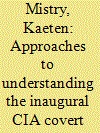

|
|
|
|
|
| Publication |
2011.
|
| Summary/Abstract |
The Italian election of April 1948 represented the first occasion on which the CIA intervened to influence events abroad. Understanding of the operation has been shaped by three dissimilar approaches that have been critical, celebratory, and stressed continuity. These approaches have, in turn, fuelled a series of useful myths around the episode. Agency declarations of greater 'openness' after the Cold War promised to advance historiographical debates on this - and other - interventions through the declassification of records, although proved a false dawn. This article offers an alternative method to analyse the case through a broader international frame of inquiry that considers CIA action in the context of both American and Italian efforts during the election. In so doing, it challenges the useful myths around 1948.
|
|
|
|
|
|
|
|
|
|
|
|
|
|
|
|
| 2 |
ID:
097300
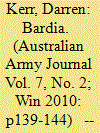

|
|
|
| 3 |
ID:
088723
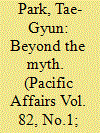

|
|
|
| 4 |
ID:
164804
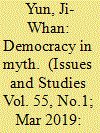

|
|
|
|
|
| Summary/Abstract |
After undergoing a series of mass demonstrations during the past three decades, including the 2016–2017 candlelight protests that led to the impeachment of President Park Geun-hye, many commentators in South Korea are confident that their country has become a land for what Karl Marx called “free men.” Korean citizens are portrayed as being ready to participate in voluntary political associations and collective actions and to pursue their interests in the public sphere. However, the data are showing the opposite to be true: citizen participation in public-sphere activities has substantially decreased since the mid-2000s, while the government has managed to improve or at least maintain its political responsiveness during the same period. Explaining the unnoticed background to this imbalance, this essay sheds light on the myth of the benefactor state in Korean democracy, arguing that this has emerged because neoliberalism has not only placed an increasing number of people in precarious positions but also neutralized them politically. The Korean government has capitalized on this situation to mythicize itself as a benefactor state that possesses an incomparable administrative capacity to take care of precarious people. By investigating the period of Park’s presidency (2013–2017) and the current rule of President Moon Jae-in (2017–), this essay shows how the myth of the benefactor state has emerged and created a unique cycle of Korean democracy.
|
|
|
|
|
|
|
|
|
|
|
|
|
|
|
|
| 5 |
ID:
052791
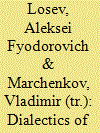

|
|
|
|
|
| Publication |
London, Routledge, 2003.
|
| Description |
vii, 235p.
|
| Standard Number |
0415284678
|
|
|
|
|
|
|
|
|
|
|
|
Copies: C:1/I:0,R:0,Q:0
Circulation
| Accession# | Call# | Current Location | Status | Policy | Location |
| 048342 | 291.13/LOS 048342 | Main | On Shelf | General | |
|
|
|
|
| 6 |
ID:
154496


|
|
|
|
|
| Summary/Abstract |
This article discusses the depiction of the exodus myth in advertisements in Israeli secular and religious daily newspapers from 1948 to 2008. Its premise is that advertising as a persuasive communication tool adapts itself to its target audience. As a result, there are notable differences in the use of the myth in advertisements targeting various audiences. A total of 1907 advertisements were examined with the use of quantitative content analysis. The research premise was extensively substantiated and can point to the differential perception of the exodus myth among Israel’s secular and religious populations.
|
|
|
|
|
|
|
|
|
|
|
|
|
|
|
|
| 7 |
ID:
096519
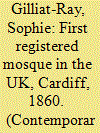

|
|
|
| 8 |
ID:
097683
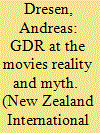

|
|
|
| 9 |
ID:
095777


|
|
|
| 10 |
ID:
101765
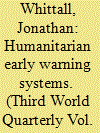

|
|
|
|
|
| Publication |
2010.
|
| Summary/Abstract |
The field of humanitarian early warning has emerged as a way to alert governments about countries facing imminent humanitarian crises, based on indicators of potential conflict, food shortages and other related issues. Early warning as a technical field has often failed because intervention in another state is based on national self-interests and the constraints of sovereignty. Governments continue to be unresponsive to areas outside of these considerations. Because this reality is overlooked, all the literature reviewed focuses on the technical fixes required to address the well known failures in early warning. As such, humanitarian early warning is frequently inconsequential at best, and at worst it has become instrumentalised by states to justify their interventions in countries based on their national self-interest, which is increasingly linked to national security in the era of the so-called 'global war on terror'.
|
|
|
|
|
|
|
|
|
|
|
|
|
|
|
|
| 11 |
ID:
129903
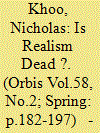

|
|
|
|
|
| Publication |
2014.
|
| Summary/Abstract |
The author contends that prominent strands in the recent literature on Asia's international relations reflect a lack of appreciation for the actual policy of regional states, which is deeply realist in orientation.
|
|
|
|
|
|
|
|
|
|
|
|
|
|
|
|
| 12 |
ID:
097182
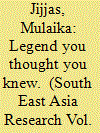

|
|
|
|
|
| Publication |
2010.
|
| Summary/Abstract |
This article traces the evolution of narratives about the supernatural woman said to live on Gunung Ledang, from oral folklore to sixteenth-century courtly texts to contemporary films. In all her instantiations, the figure of Puteri Gunung Ledang can be interpreted in relation to the legitimation of the state, with the folklore preserving her most archaic incarnation as a chthonic deity essential to the maintenance of the ruling dynasty. By the time of the Sejarah Melayu and Hikayat Hang Tuah, two of the most important classical texts of Malay literature, the myth of Puteri Gunung Ledang had been desacralized. Nevertheless, a vestigial sense of her importance to the sultanate of Melaka remains. The first Malaysian film that takes her as its subject, Puteri Gunung Ledang (S. Roomai Noor, 1961), is remarkably faithful to the style and substance of the traditional texts, even as it reworks the political message to suit its own time. The second film, Puteri Gunung Ledang (Saw Teong Hin, 2004), again exemplifies the ideology of its era, depoliticizing the source material even as it purveys Barisan Nasional ideology.
|
|
|
|
|
|
|
|
|
|
|
|
|
|
|
|
| 13 |
ID:
117888
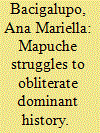

|
|
|
|
|
| Publication |
2013.
|
| Summary/Abstract |
The biographical mythohistory of Rosa Kurin, an ethnically mixed Mapuche-German shaman in southern Chile in the late 1800s, expresses a 'shamanic historical consciousness' that advances current debates over the dynamic relationship between history and myth and between indigenous and national history. Biographical mythohistory is a mixed genre that mediates among different memoralisations of the past to obliterate dominant Chilean history and to create alternative indigenous histories. Mapuche shamanic mythohistories are simultaneously linear and cyclical: historical personages are transformed into mythical characters and sometimes back again, and mythical happenings manifest themselves repeatedly in historical events. Mapuche people create mythohistories by mythologising such shamans and historical outsiders, prioritising spiritual agency over political agency and narratively reversing the usual colonial dynamics of subordination. Mythohistories are, for rural Mapuche, a means of conveying agency, ethnic identity and ontology. They also offer a way to decolonise Mapuche history and have the potential for political mobilisation.
|
|
|
|
|
|
|
|
|
|
|
|
|
|
|
|
| 14 |
ID:
124373
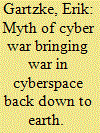

|
|
|
|
|
| Publication |
2013.
|
| Summary/Abstract |
A blitz of media, punditry, and official pronouncements raise the specter of war on the internet. Future conflicts may well take place in cyberspace, where victory or defeat could be determined in mere "nanoseconds."1 Secretary of Defense Leon Panetta has even warned of a "cyber-Pearl Harbor."2 Nor are fears of cyberwar abstract speculation. Events such as the denial of service attacks against Estonian and Georgian government websites, the Stuxnet worm designed to disable Iranian nuclear centrifuges, and the recent hacking of U.S. military computer networks seem to indicate that the era of cyberwar has already arrived.
|
|
|
|
|
|
|
|
|
|
|
|
|
|
|
|
| 15 |
ID:
093026
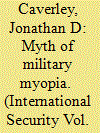

|
|
|
|
|
| Publication |
2009.
|
| Summary/Abstract |
A capital- and firepower-intensive military doctrine is, in general, poorly suited for combating an insurgency. It is therefore puzzling that democracies, particularly the United States, tenaciously pursue such a suboptimal strategy over long periods of time and in successive conflicts. This tendency poses an empirical challenge to the argument that democracies tend to win the conflicts they enter. This apparently nonstrategic behavior results from a condition of moral hazard owing to the shifting of costs away from the average voter. The voter supports the use of a capital-intensive doctrine in conflicts where its effectiveness is low because the decreased likelihood of winning is out-weighed by the lower costs of fighting. This theory better explains the development of the United States' counterinsurgency strategy in Vietnam during Lyndon Johnson's administration compared to the dominant interpretation, which blames the U.S. military's myopic bureaucracy and culture for its counterproductive focus on firepower and conventional warfare.
|
|
|
|
|
|
|
|
|
|
|
|
|
|
|
|
| 16 |
ID:
093398
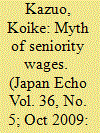

|
|
|
| 17 |
ID:
087520
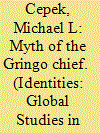

|
|
|
|
|
| Publication |
2009.
|
| Summary/Abstract |
In this article, I investigate the sociocultural grounding and sociopolitical position of Randy Borman, the "gringo chief" of the indigenous Cof n people of Amazonian Ecuador. Born to North American missionary-linguists, Borman grew up in Cof n communities, attended school in urban Ecuador and the United States, and developed into the most important Cof n activist on the global stage. I consider him alongside other ethnically ambiguous leaders of Amazonian political movements, whom anthropologists have described as "messianic" figures. The historians and ethnographers who write about Amazonian messianism debate the relationship between myth and reason in indigenous political action. Using their discussion as a starting point, I propose the concept of "mythical politics," a type of transformative action that concentrates enabling forms of socio-temporal mediation in the shape of individual actors and instantaneous events. I develop my approach through a discussion of the work of Georges Sorel, Georg Luk cs, and Antonio Gramsci, three theorists who debate the role of myth in political mobilization. By applying their insights to the case of Borman, I explore the relationship between myth, mediation, and rationality in Cof n politics and political movements more generally.
|
|
|
|
|
|
|
|
|
|
|
|
|
|
|
|
| 18 |
ID:
159266


|
|
|
| 19 |
ID:
141042
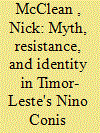

|
|
|
|
|
| Summary/Abstract |
Since the end of the Indonesian occupation of Timor-Leste in 1999, a significant revival of local cultures and identities in public life has been occurring. In this article I discuss aspects of identity and culture among Fataluku-speaking people in relation to the recent establishment of the Nino Conis Santana National Park over much of their homeland. Today Fataluku cultural and historical stories provide a basis for their status as an autonomous and sovereign cultural group, as well as a legacy of intercultural negotiation and alliance that arguably reflects regional patterns of migration and social change over thousands of years. With the park's 15,000 residents continuing to rely on its forests and reefs for subsistence, recent restrictions on hunting have highlighted the need for increased local community support if the park is to achieve its conservation aims. I argue that long-standing traditions surrounding the negotiation of social and political change within Fataluku society provide a potential basis for cooperation with the new nation–state and for developing community-oriented park management policies.
|
|
|
|
|
|
|
|
|
|
|
|
|
|
|
|
| 20 |
ID:
087491
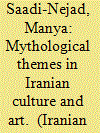

|
|
|
|
|
| Publication |
2009.
|
| Summary/Abstract |
In Iran, ancient mythical elements are very much alive in the present as a part of the fabric of ordinary people's lives and worldview. This paper explores the relationship between culture, myth, and artistic production in contemporary Iran, using the specific examples of symbols and mythological themes evoked in the work of painter/writer Aydin Aghdashloo and photographer/video artist Shirin Neshat. The paintings of Aghdashloo, in which he deliberately damages beautifully-executed classical style Persian miniatures, convey a sense that the angelic forces have failed and that the world is succumbing to the destructive and degenerative activities of the demonic. The photographs, videos and installations of Neshat likewise draw heavily on cultic forms inherited from ancient Iranian tradition. It is important to note that in none of these cases does the artist use mythological themes and symbols to express their original cultural meaning; rather, they appropriate well-known elements of ancient Iranian culture and imbue them with new meanings relevant to contemporary issues and understandings. What these examples do illustrate is the persistent resonance of ancient Iranian culture among Iranians up to the present day. Iranian artists have demonstrated the effectiveness of evoking their target audience's deep sense of cultural identity to convey contemporary messages using ancient cultural concepts, sometimes on a subconscious level.
|
|
|
|
|
|
|
|
|
|
|
|
|
|
|
|
|
|
|
|
|